Hot Line
18023083247
The definition and development of 3D printing
3D printing, also known as additive manufacturing technology, is a technology that uses powdered metal or plastic and other bondable materials based on digital model files to construct objects through layer-by-layer printing, usually using digital technology materials. Printer to achieve.
3D printing originated in the United States at the end of the 19th century. The core idea of 3D printing was pioneered by photographic sculpture and geomorphic technology researched in the United States. In 1984, Charles Hull transformed optical technology into the field of rapid prototyping, and established the world in 1986 3D Systems was the first company to produce 3D printing equipment. Since then, many 3D printing companies have emerged in the United States. In the following 30 years, 3D printing technology continued to innovate, application areas continued to expand, and the 3D printing industry gradually matured.
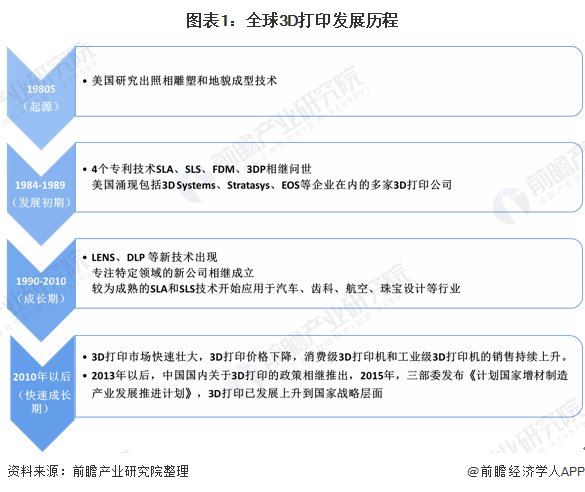
At present, 3D printing is mainly divided into two types: desktop and industrial. The desktop level is the primary and introductory stage of 3D printing technology, which can explain the process principles of 3D printing technology intuitively. Because desktop 3D printers are relatively cheap, convenient to carry, and easy to operate, their application scenarios are mainly concentrated in home, office and other scenarios.
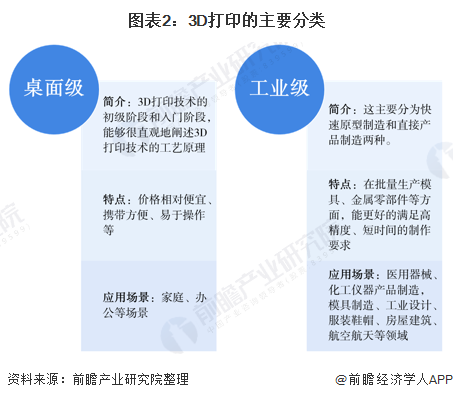
China's 3D printing industry chain is at an early stage of development
At present, my country's 3D printing industry is still in the early stage of development. The initial stage of the 3D printing industry chain mainly includes the initial raw material processing, equipment manufacturing and the final printing applications and services.
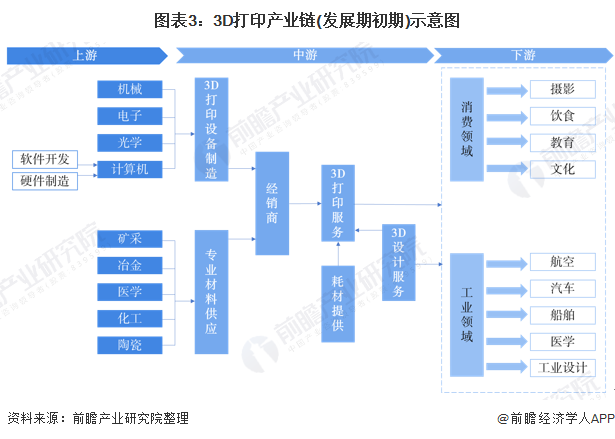
Development status of China's 3D printing industry
—Industry scale has accelerated year by year
In recent years, the application of my country's 3D printing market has continued to deepen, and it has been widely used in aerospace, automotive, shipbuilding, nuclear industry, molds and other fields. From 2017 to 2019, the scale of my country's 3D printing industry has increased year by year, and the growth rate is slightly faster than the overall global growth rate, so that the proportion of my country's 3D printing industry in the world is increasing. According to the "Global and China 3D Printing Industry Data in 2019" released by CCID in March 2020, the scale of China's 3D printing industry in 2019 was 15.75 billion yuan for the printing industry, an increase of 31.1% from 2018.
In 2020, the global outbreak of the new crown epidemic, the shortage of medical protective equipment in various countries, at this time 3D printing plays a role of rescue. Data on AliExpress, the country's largest B2C cross-border e-commerce platform, shows that my country's 3D printer sales were booming during the epidemic. Since the epidemic, the sales of 3D printers on this platform have doubled compared with 2019. The scale of my country's 3D printing industry is expected to reach 20.8 billion yuan in 2020.
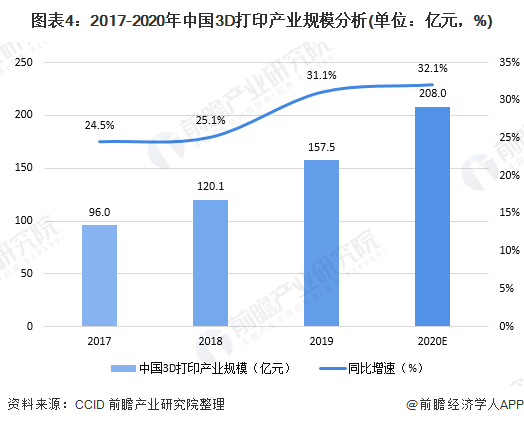
—The largest proportion of 3D printing equipment scale
The 3D printing industry is mainly composed of three sub-sectors of 3D printing equipment, 3D printing materials and 3D printing services. In 2019, the scale of China's 3D printing equipment industry was 7.086 billion yuan, accounting for the highest proportion, reaching 45%; the scale of the 3D printing service industry was 4.567 billion yuan, accounting for 29%; 3D printing materials industry scale is 4.094 billion yuan, accounting for 26%.
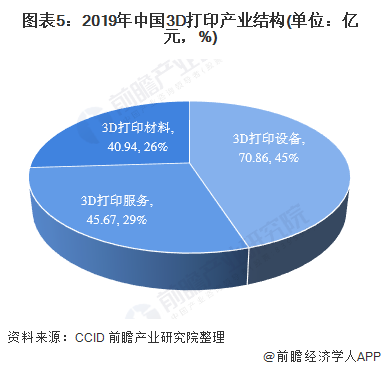
—Imported 3D printing equipment is mainly high-end commercial products
The price of 3D printers is different depending on the purpose. Generally, commercial printers have higher prices, ranging from tens of thousands to hundreds of thousands; cheap 3D printers can already be purchased on domestic shopping websites, and prices range from 3,000 to 5,000 yuan. Equipped with quick start guide, corresponding software download, machine correction and other introductions.
In terms of the import and export of 3D printing equipment, according to the China Petroleum and Chemical Industry Federation, the average import price of 3D printers in China from May 2019 to May 2020 fluctuated and declined. In May 2020, the average import price of 3D printers in China was US$4313.58 per set, a decrease of 20% from the previous month. The average export price was US$186.12 per unit, an increase of 13% from the previous month. It can be seen that the average import and export price of China's 3D printers has a large gap. The average import price is about 23 times the average export price. The imported products are mainly high-end commercial products.
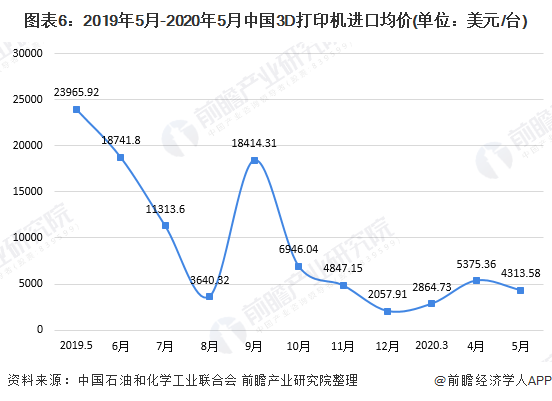
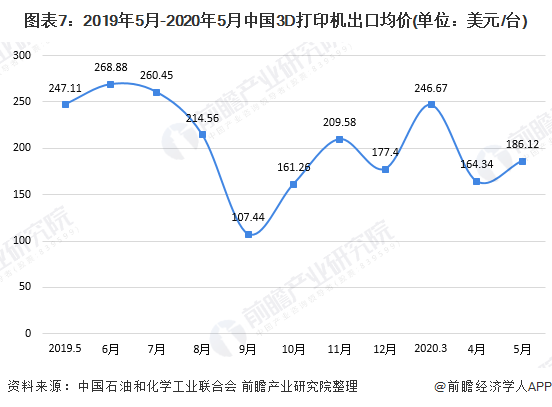
—East China is the main enterprise gathering area
East China is the main gathering area for 3D printing companies in my country. According to data released by CCID, the number of 3D printing companies in East China in 2019 accounted for 42.4% of the country. There are also outstanding enterprises in Central South, North China, Southwest and other regions, accounting for 23.8%, 13.9% and 8.4% respectively. Well-known 3D printing companies in East China include Hunan Huashu High-tech Co., Ltd., Hangzhou Xianlin 3D Technology Co., Ltd., Shanghai Guangyunda 3D Technology Co., Ltd., Shanghai Manheng Digital Technology Co., Ltd.; well-known 3D printing companies in Central and South China include Shenzhen Guanghua Weiye Industrial Co., Ltd., Hubei Jiayi Sanwei Hi-Tech Co., Ltd., etc.
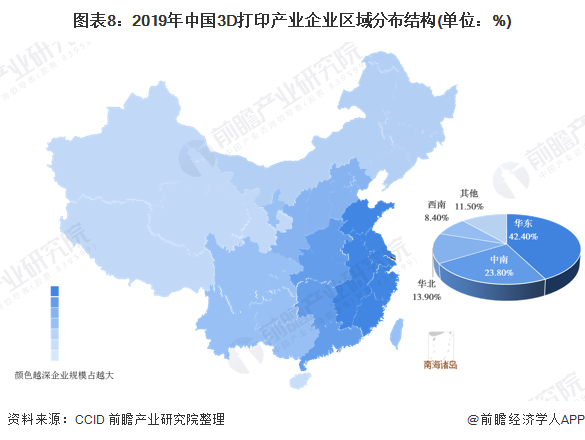
Higher demand for metal printing materials in the upstream of the industrial chain
3D printing materials mainly include metals, ceramics, plastics, cell tissues, gypsum, inorganic powders, photosensitive resins, etc. At present, plaster, inorganic powder, photosensitive resin, plastic, etc. may be able to meet the general needs of 3D printing, and plastic printing products such as toys can be used directly. However, the application of only titanium, stainless steel, gold and silver for industrial-grade metal powders is still limited by technology, and the application range is relatively narrow.
As an important factor in determining the development process of 3D printing technology, the status of 3D printing materials is gradually increasing. With the gradual popularization of 3D printing technology, the demand for materials is also rising rapidly. According to the "Global and China 3D Printing Industry Data for 2019" released by CCID Consulting in March 2020, the scale of China's 3D printing material industry reached 4.094 billion yuan in 2019, an increase of 26.2% over 2018, and it accounts for the proportion of the 3D printing industry. 26%.

Among 3D printing materials, metal materials account for a relatively large proportion. According to data released by CCID, in 2019, in the structure of China's 3D printing materials industry, the scale of non-metallic materials industry is 2.538 billion yuan, accounting for the highest proportion, reaching 62%; metal materials industry The scale is 1.556 billion yuan, accounting for 38%.
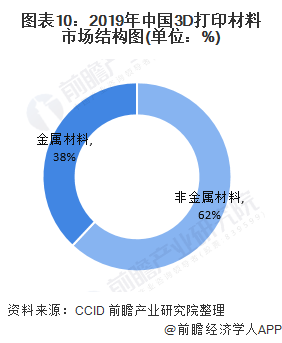
Applications in the downstream industrial fields of the industrial chain account for more than 60%
The downstream of the 3D printing industry chain is mainly divided into two categories: civil consumption fields, such as photography, food, education, etc.; industrial fields, such as traditional aviation, automobiles, ships, electronics, home appliances, medicine, construction and other industries, and also Including the fields of jewelry, fashion, food, textiles and archaeology.
According to the "Wohlers Report 2020" questionnaire survey, the industry that uses 3D printing the most in the global 3D printing industry is the automotive industry, which is far ahead, accounting for 16.4%. Consumer/electronics and aerospace followed closely with 15.4% and 14.7% respectively.
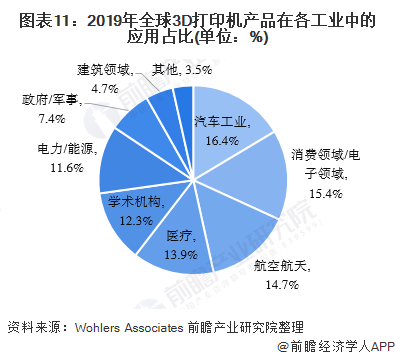
Note: Other fields refer to other industrial fields in a wider range that are not listed in the column, such as mineral processing, chemical industry, water treatment, wood/paper and other industries that have not been listed separately.
my country's 3D printing is mainly concentrated in the fields of home appliances and consumer electronics, architecture, education, mold testing, medical and dental orthodontics, cultural creativity and cultural relic restoration, automobiles and other vehicles, aerospace and other fields. Among them, the three largest demands for 3D printing come from civilian consumption, industrial design, and aerospace and military industry.
According to data released by CCID, in 2019, in the structure of China's 3D printing application service industry, the industrial application service industry scale was 2.923 billion yuan, accounting for 64%; the consumer application service industry scale was 1.644 billion yuan, accounting for 36%.
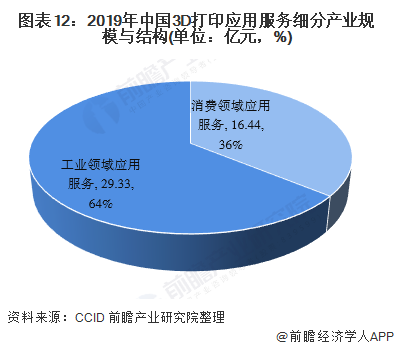
Development prospects of China's 3D printing industry
—The professional division of labor in the industry chain is further deepened
At this stage, major 3D printing companies generally exist in a comprehensive form of material supply, equipment manufacturing and printing services. This is caused by the restriction of technology promotion and market scale in the early stage of industrial development. In the long run, the professional division of labor in the 3D industry chain will further deepen, professional material suppliers and professional printing companies will appear, and product design services will be independent or transferred to downstream consumer companies. At the same time, there will also be service platforms for third-party testing and verification, finance, e-commerce, and intellectual property protection that provide support services for the 3D printing industry. In the mature period of the industry, a complete 3D printing industry chain should include: 1) Upstream: professional material suppliers, 3D printing equipment manufacturers, software developers, digital technology providers, consumables providers, professional design agencies, 3D printing equipment Dealer, 3D